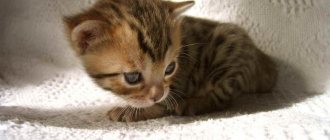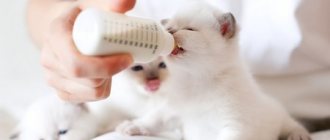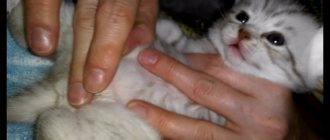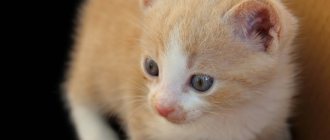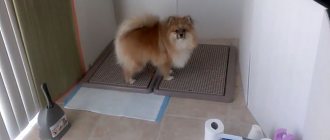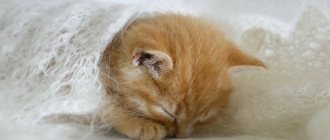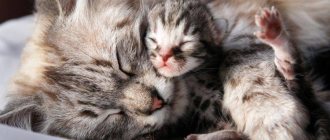When a cat has reached three weeks of age, its intestinal tract is already formed and, having a complete microflora, is ready to digest food intended for older individuals. During this period, the baby’s main food is still mother’s milk, but complementary foods are offered in a creamy consistency or in liquid form. At one month of age, when kittens begin to go to the toilet on their own , the cat continues to help them in this process and supports them for some more time.
Acts of bowel movements and urination at different ages
A healthy kitten visits the restroom often. The health of the kitten depends on the number of visits, so it is important for a loving owner to monitor the rhythm of visiting the toilet. It is also important to find out what measures should be taken if the kitten “keeps everything to himself.”
Newborn kittens
In the first 3 weeks after birth, the mother cat helps her kittens with going to the toilet. By licking them according to the call of instincts, she cleanses babies of dirt, bad odors and activates blood circulation in the digestive organs. Massaging the mother cat helps the kittens get rid of gas and “do their job” - defecate.
If there is no mother cat nearby, the owners become responsible to the kitten. They should stroke the baby every 2 hours before and after meals.
A tiny kitten may refuse to defecate. Gases accumulate in a bloated tummy, and certain manipulations will help eliminate them:
- the owner takes cotton wool;
- wets it in water at room temperature;
- massages the baby's tummy clockwise with it.
Period
By the 3rd week after birth, the kitten is ready to accept more adult food: its intestines are formed and have beneficial microflora. Even if the baby is still feeding on mother cat's milk, you can start introducing liquid food into his diet. At the 3rd week, the reflex of urination and defecation has already been formed, so the kitten goes to the toilet every 4-6 times a day.
Normal bowel movements:
- mushy appearance;
- uniform and thick;
- do not have impurities (for example, undigested pieces of food).
The kitten is energetic and perky. If the stool is liquid or very dry, this is a reason to think about visiting a veterinarian.
You can try massaging in a circular motion. Since there is no mother nearby, responsibility for the baby’s health falls on the owners.
Adults
From 1 to 3 months, the kitten can already switch to adult food. During this period, you should no longer be afraid if the feces are hard - that’s how it should be. The consistency of stool and the regularity of going to the toilet during this period is an individual matter.
A kitten eating food with a high fiber content goes to the toilet more often.
Grown-up kittens go to the toilet regularly and the feces of a healthy pet should not contain undigested food or strange mucus.
When kittens begin to eat on their own: schedule for transition to “adult” food
Kittens are born toothless. The absence of teeth, the first of which erupt at 7–14 days of age (and the dentition is completely filled with them by 2 months), allows babies to feed only on mother’s milk. This continues during the first few weeks of life. Breast milk is important for babies. It contains microelements and antibodies that contribute to the formation of colostral immunity.
In the first days of life, kittens' diet consists of colostrum, which is eventually replaced by milk. Breastfeeding by a cat of its cubs lasts from 40 to 60 days. Sometimes it lasts up to 6 months. It is recommended to introduce the first complementary foods to babies at 3–4 weeks of age, since it is from this moment that the nursing pet’s milk production gradually decreases. The cubs can eat on their own after about 1 month.
Deviations from the norm in the toilet: causes of the disease
It happens that a kitten has an abnormal frequency of urination. They are divided into 2 cases: safe and incorrect.
The first include:
- acclimatization;
- menu changes;
- stress caused by adopting or adding a new pet to the family;
- operations: sterilization or castration.
The factors listed above are only temporary difficulties. After adaptation, everything returns to normal.
There are also more serious reasons. If urination brings pain to the animal or urine is released in limited quantities, this is an alarming sign.
Pathologies are cases when:
- there is mucous secretions or blood in the urine;
- limited discharge;
- heat;
- bloated tummy;
- plaintive meowing during bowel movements;
- inability to urinate;
- hot ears;
- dry nose;
- lethargy, reluctance to eat your favorite food.
You can tell that a pet is sick by its condition. The animal sits in an unnatural position:
- the animal's body is hunched;
- muscles are tense;
- the back is arched.
At the same time, the animal may cry pitifully. The kitten may also refuse to go to the toilet if the tray has not been washed for a long time or if it is dissatisfied with the litter.
Prevention of constipation and diarrhea in kittens
If the owner prefers to feed his little furry with natural products, you need to make sure that the diet contains not only meat, but also vegetables and cereals - these menu components have a positive effect on intestinal motility. Older cats need to add a small amount of steamed bran to the minced meat, which contributes to the balanced functioning of the digestive system.
The diet should definitely include cereal dishes such as well-cooked rice and buckwheat porridge, thoroughly mixed with minced chicken. A stew made from vegetables stewed or boiled in a small amount of water is appropriate. Instead of water, you can use weak meat broth. For vegetables, you can take carrots, beets, pumpkin, or zucchini, cut into small cubes.
Some pets themselves are drawn to cucumber, cabbage, melon, or green peas. In these cases, you need to encourage their appetite and provide your beloved pet with these foods. After all, melons, along with fresh vegetables, help improve intestinal function and help overcome chronic constipation.
How to train a kitten to use a litter tray?
So, we found out when kittens begin to go to the toilet on their own, now let’s figure out how to accustom the little ones to the litter box. Of course, everyone who is faced with the issue of training wants to receive win-win advice, but all animals are different and approaches to them differ. Let's try to highlight the main methods:
- Tank training. This point is the first and easiest. The baby just needs to see his tray and understand what the owner wants from him. You can hurry up the kitten by massaging its tummy with light movements. A kitten that has gone to the toilet once in the right place will most likely return to the same place. After each visit to the toilet, it is advisable to lightly clean the tank - it should not smell bad. Cats are clean animals, and if they refuse a tray or bowl of food, then they are dirty.
- Several trays. You can try a clever trick - place several trays around the house in different corners (or in a place the predator likes). When kittens start going to the toilet in one of the places prepared for them, they get used to it and will come back. All that remains is to remove the extra trays. Do not forget that the animal does not get used to the tank, but to the place.
- Moving around the house. It is worth following where the baby will go after the meal. If he starts to worry and hesitate, you can safely put him in the tray. After the “deeds are done,” the baby needs to be petted - this will let him know that he did the right thing, and as a bonus, give him a treat.
- Attractive methods. Special luring agents can accustom a kitten to the litter tray - that’s what they’re called. You can also use the scent of valerian or catnip.
Expert opinion
Dusheba Vera Ivanovna
In 2010, she graduated from the Moscow State Academy of Veterinary Medicine named after K.I. Scriabin with honors, specializing in veterinary medicine. I regularly attend veterinary conferences, congresses, and webinars.
Kittens themselves notify their owners of their desire to go to the toilet. As a rule, they begin to meow and look for a secluded place. If the baby begins to defecate in the wrong place, he needs to be placed in a tray. But the kitten should not be afraid - screaming and teaching are completely inappropriate.
Breastfeeding kittens are unlikely to understand what is being asked of them. Up to a certain point, the mother cat herself takes care of cleaning up the waste products of her cubs, so the baby will need more time to master it. There is no need to scold the kitten.
Professional veterinary care
The following activities require more experience with animals. And some of them are not at all advisable for an owner who has never encountered anything like this before. The best option is to talk to a veterinarian who will examine the kitten, give recommendations for further therapy and tell you how not to harm the baby.
Professional assistance includes the following:
- Abdominal massage. Somewhat reminiscent of the one they make for small children. These are circular stroking movements with your hand, which should start the work of the gastrointestinal tract. Massage will help your kitten if constipation is caused by poor diet, stress, or a small foreign body that can come out naturally.
- Duphalac, Lactusan and other similar lactulose-based drugs. They are prescribed for constipation in newborn children, and in the case of animals they will also be safe and effective. The drugs can be given to a pet who is several weeks old if he has been transferred to artificial feeding. The dose is selected taking into account the weight of the kitten.
- Vaseline oil. To some extent, a universal product: it can be dropped into the kitten’s mouth or added to food when taking emergency measures, as well as for prevention. Vaseline oil is often used in an enema. The product is not absorbed into the blood and intestines. When it enters the gastrointestinal tract, it envelops the intestinal walls with a film and covers feces, making them softer and faster out of the body. Usually the kitten is allowed to give Vaseline oil 2-3 times a day. It is better to discuss the permissible amount with your veterinarian.
- Soap in the form of a small candle. It is inserted into the kitten's anus if there are no signs that it is inflamed. A side effect when providing assistance in this way is sometimes an allergy to the composition of the soap, so it is recommended to choose only children's soap.
- Enema. To carry out the procedure, you can use a small bulb or a 10 mm syringe without a needle. Pure water or chamomile solution are suitable as a solution. The tip must be lubricated with greasy cream or Vaseline oil. The liquid is administered through the anus very carefully - the pet should be in a standing position over a tray or other container. It is undesirable to carry out the procedure yourself if the owner has never seen how it is done. The reason is that if you introduce a lot of liquid, the intestinal walls can burst, and this is fraught with more serious problems than constipation. An enema is also dangerous if there are neoplasms, foreign objects and wounds in the gastrointestinal tract. Typically, the cleansing procedure is carried out by a veterinarian after the cause of constipation has been determined.
The specialist determines the cause of constipation in a week-old, month-old or older kitten, and also decides what to do next after taking a full history. It includes:
- conversation with the owner;
- blood, urine and stool tests;
- X-ray with contrast agent:
- Ultrasound of the abdominal cavity.
In some cases, an MRI is performed - the procedure allows you to confirm or refute the suspicion of oncology.
Based on the results of the examinations, treatment is selected for the kitten. Sometimes it involves an enema, an IV with a maintenance drug, and surgical removal of a foreign object. After visiting the veterinarian and receiving recommendations, you must strictly follow all instructions to prevent complications of the disease. It is very important to complete treatment, including when it seems that your pet is no longer constipated.
How to avoid urinary problems?
Every loving owner wants his animal to be healthy and active. To avoid problems with urination, you should resort to preventive measures. If problems arise, it will not be easy to get rid of them.
Preventive measures:
- the kitten should be warm (hypothermia should not be allowed);
- the predator's menu should include only acceptable food products, and prohibited ones should be excluded (you can read the list of such products that you cannot feed cats or ask your veterinarian);
- drinking water should always be clean, and the cat should always have quick access to liquid;
- You need to play with the predator so that it remains active, because movement is life.
In case of problems with urination, you should find a good veterinarian in your city and consult with him.
From 3 weeks of age, kittens can already go to the toilet on their own, and as they grow older, trips should not exceed 10 times a day and be less than 5 times. By and large, the norm is 3 trips per day. If hikes deviate from the norm, this is a reason to think about it. The kitten should go to the toilet with ease and without pain. The main thing to remember is that the baby is just getting used to it, there is no need to put pressure on him. Soon he will understand where his toilet is.
Why does a cat wheeze when it meows: health problems
Meowing often serves as a signal of pain experienced by a furry pet. Then it sounds like a kind of call for help, often turning into sharp or unusual sounds for a particular animal. Hoarseness that appears as if out of nowhere should especially alert loving owners. Often it serves as evidence of a viral infection of the larynx and vocal cords, noted in respiratory ailments. It is highly recommended to take such a cat to the veterinarian. One of the recommendations is to drink warm water.
Useful video
Get acquainted with interesting cat breeds with the help of our encyclopedia: Karelian Bobtail, Ragamuffin, LaPerm.
How many times should a cat go to the toilet, small and large?
How to train a kitten to use a litter tray?
How many times a day does a kitten pee?
When you bring home your new kitten, you probably have a lot of questions. And one of them might be: “How often do kittens pee?”
Because kittens typically use their own litter box, kitten owners are at a distinct disadvantage compared to puppy owners. If you have a dog, you'll usually have a good idea of how often he pees because you'll often be on walks with him!
Kittens tend to urinate in private and are oblivious to their toilet habits. So how do you know how many times your kitten pees?
What to do if a kitten grows up without a mother cat?
It doesn’t always turn out that a small pet grows up next to its mother. In this case, you should become the baby's mother.
It is you who will have to feed the animal and help it with bowel movements. It should be remembered that food for a kitten up to a month should only be liquid or semi-liquid. This has a significant impact on the process of emptying it. If you do not know what to feed a one-month-old kitten, it is better to contact a veterinary pharmacy. There they will help you choose the optimal “baby” food for your ward.
If you don't know how often little kittens poop, pay attention to the appearance of their bellies. When it is swollen, it means that the baby has problems with bowel movements. Perhaps he simply cannot yet, due to his age, do without outside help.
A bloated stomach will cause him pain. You are required to gently massage his abdomen, avoiding strong pressure. Then you need to take a piece of gauze and soak it in warm water. Use the device to slowly massage the outlet of the rectum. These manipulations should help the kitten begin to relieve itself. Perhaps in the future he will no longer need your help.
